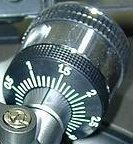|
Table Of Contents
Page
1......The Drive System
Page 2......The
Tonearm
Page 3......The Mod
Process
Page 4......Power
Delivery
KAB Main 1200 Page
Getting Your
Bearings
Here's something to think about: how many
high end tonearms can you name that specify bearing finish and friction?

Well, while you ponder that, consider this: the Technics SL-1200
tonearm is specified to have a bearing finish of ± 0.5 microns. This and
the extra closeness of pivot center to the bearings results in a minimal
friction of 7 milligrams. It is important to note that the1200 arm was designed
at a time when tracking forces were pushing the 0.75 gram range. So a good
margin of safety would place the bearing friction at 100 times less than that.
Bearing
friction should be 100 times less than the tracking force.
Unless the bearing friction is sufficiently small it can
contribute to "static damping" and that is undesirable since it increases
record wear. Very low bearing friction enables a tonearm to make the maximum
advantage of dynamic fluid damping.
Our TD-1200 fluid damping mod raises the performance of the
1200 arm to a very high standard.
|
Getting into the thick of
it
Fluid Damping all but eliminates wild low
frequency arm/cartridge resonance. This lets the arm mate with a wider array of
cartridges. It also prevents the wild and often destructive movement that can
occur on warps or from simply testing resonance. It also reduces rumble and
acoustic feedback to speakers. Fluid Damping is a good thing.

Sonically, there is a slowing down of the entire acoustic
event. There seems to be more "time" to listen. Here is a great A'gon review of
the Fluid
Damped 1200 Tonearm.
With the
KAB TD-1200 the acoustic event seems to almost stand still. Allowing more
"time" to listen.
Throwing a curve
We've all
heard the condemnation about how Japanese curved arms are not audiophile
approved. Of course, curving the wand at dissimilar lengths achieves the same
objective as tapering a straight wand: the breaking up of standing waves. The
advantage of the curved wand is that it looks prettier! Yet I cannot help but
feel that the smooth progression of the curved arm actually does a better job
of transferring -and keeping- energy away from the cartridge. One last thing,
the mass of the polished thin wall cast aluminum arm is 12 grams. That includes
the headshell. The arm resonates at 9 Hz with cartridge compliances of 30 cu.
 |
Adjustments and
Settings
It's nice to have cousins in the camera
business!. The calibrated VTA adjustment on the '1200 tonearm comes courtesy of
the same helicoid deep thread technology used in camera focus rings. Silicone
damped, and lockable, it gives a precise feel and "on the fly" adjustment of
VTA. 
Calibrated stylus force and calibrated antiskate
force are standard. The counterweight is elastomer decoupled and stays put.
 I think I have
heard about enough of counterweights that aren't calibrated or that go out of
adjustment all by themselves! The 1200 settings are repeatable and always stay
right where you leave them! I think I have
heard about enough of counterweights that aren't calibrated or that go out of
adjustment all by themselves! The 1200 settings are repeatable and always stay
right where you leave them!
 The calibrated antiskating control uses progressive
spring tension to apply the reverse skating force. The calibrated antiskating control uses progressive
spring tension to apply the reverse skating force.
This technique increases
the force gradually as the stylus progresses towards the end of the record.
This is the most predictable antiskate force design.
The
tonearm settings are repeatable and always stay right where you leave
them!
The removable computer designed cast aluminum
headshell offers great convenience to swap and compare cartridges. Finally you
can have the best cartridge for mono, stereo soundstage and tracking! |





 I think I have
heard about enough of counterweights that aren't calibrated or that go out of
adjustment all by themselves! The 1200 settings are repeatable and always stay
right where you leave them!
I think I have
heard about enough of counterweights that aren't calibrated or that go out of
adjustment all by themselves! The 1200 settings are repeatable and always stay
right where you leave them! The calibrated antiskating control uses progressive
spring tension to apply the reverse skating force.
The calibrated antiskating control uses progressive
spring tension to apply the reverse skating force.